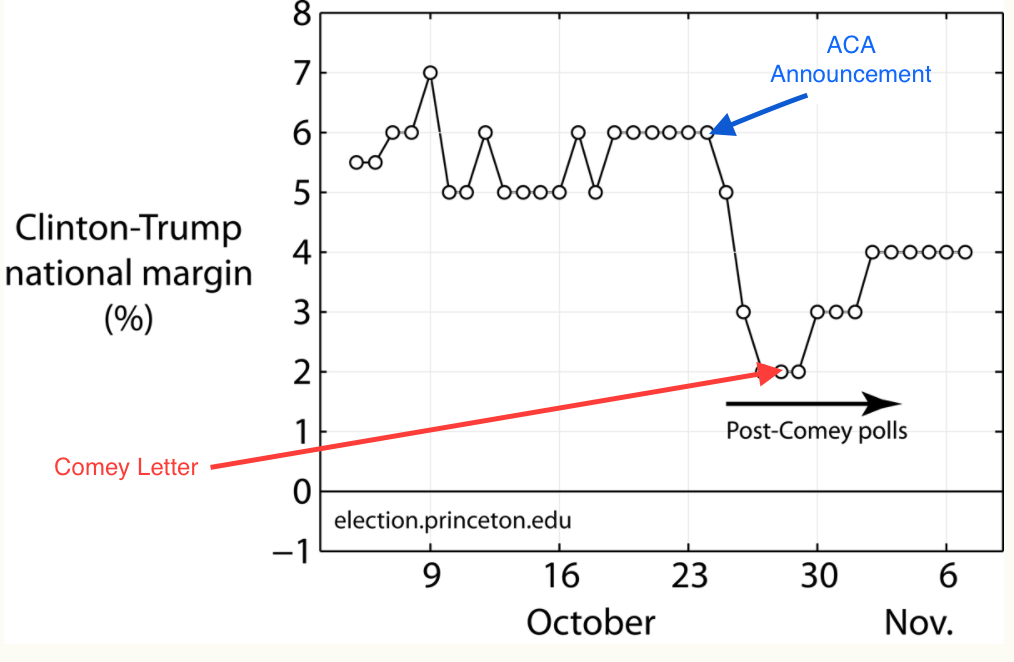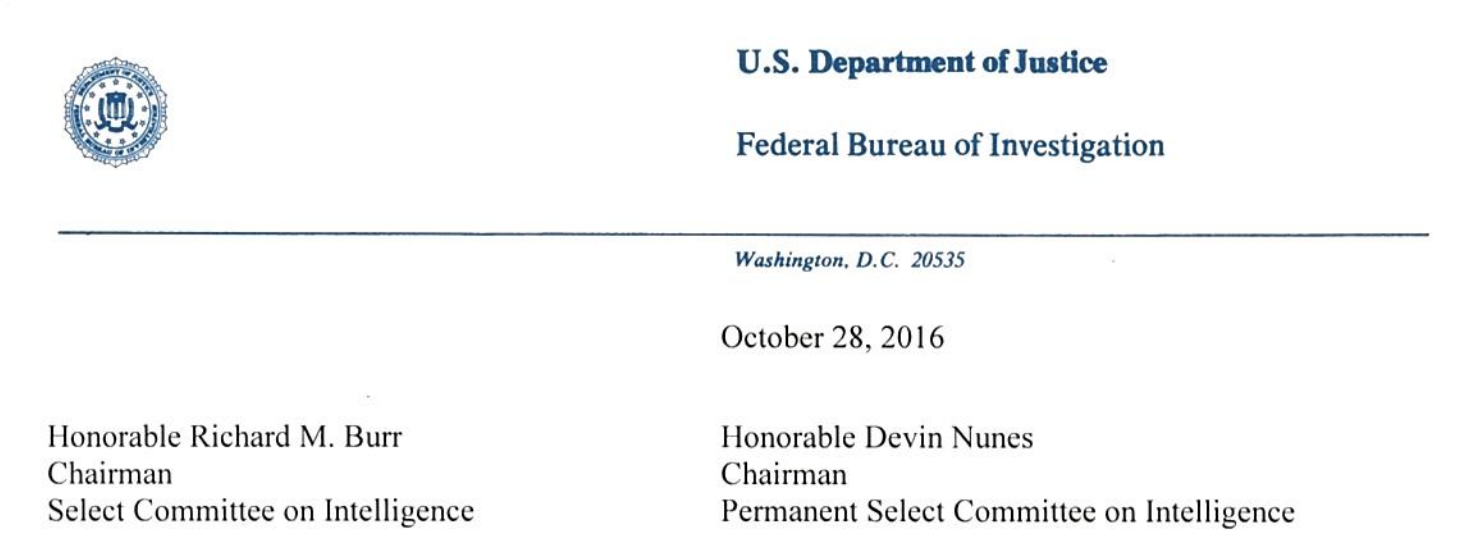The ObamaCare Not Comey Effect
Just after the election I did two posts considering the relative impact of the Jim Comey letter announcing FBI was reviewing the Anthony Weiner derived emails and the announcement of a huge ObamaCare premium spike.
I still think we don’t have enough data about the relative effect of the two events.
But a number of people are pointing to this post from Sam Wang, which ends,
In the above graph of the Comey effect, each point shows the median margin for polls that were in the field on that day. As you can see, the immediate effect of Comey’s letter was a swing toward Trump of 4 percentage points, about half of which stuck. This was enough to swing Michigan, Pennsylvania, Florida, and Wisconsin. It seems likely that Comey’s letter was a critical factor in the election outcome.
Nowhere in the post does Wang note what date Comey sent his letter, though. It was October 28.
Unless Wang’s chart is totally mislabeled (Update: In an “explanation” added to his post, Wang effectively says his graph is off by three — though not four — days due to the way he presents multi-day polls; he has, at least, now told his readers when the actual letter came out) but what it shows seems to be consistent with what I showed in this post, which shows a Hillary dip and a Trump spike moving in concert on before October 28), then his chart show doesn’t support a Comey effect at all — it shows the opposite. The differential started narrowing after October 24. By October 28, when the letter was released, the differential had plateaued before it turned up again.
As it turns out, the ObamaCare spike was announced on October 24 (and reported heavily starting October 25).
That’s precisely when we see the differential moving.
If we’re assuming an immediate response in polls in response to an event, then the ObamaCare premium spike would be a far better explanation than the Comey letter, which took place later.
Frankly, I suspect both had an impact, and further suspect there may have been something else driving the differential late turn to Trump in the Rust Belt. And I suspect we still don’t have the data to explain what made a bunch of Rust Belt voters move to Trump right before the election.







Bullseye.
As per usual.
Paul Ryan wants to turn Medicare into Obamacare.
Will Dems have the spine to point that out.
Warren Mosler @wbmosler has the democratic capitalist answer to health care that federalizes all health care liabilities.
“Every” adult “gets $5,000 on January 1 each year to spend on health care.
$1,000 is for preventative care, and the other $4,000 is for all other health care needs.
If you need more than that you are covered by a form of Medicare.
At year end you get the unused portion of the $4,000 as a gift with no strings attached.
You are free to buy any private insurance or medical plan you wish.
Children under 18 would be covered by Medicare and not participate in this plan. I don’t want to give parents a cash incentive to not take their children to the doctor.”
Assuming 300 million adults not on Medicare, Mr. Mosler estimated the pay-outs would cost $1.5 trillion ($5,000×300 million people) annually.
http://www.huffingtonpost.com/warren-mosler/a-progressive-health-care_b_521651.html
From the Office of the Comptroller of the Currency:
“The notional amount of derivative contracts held by insured U.S. commercial banks and savings associations in the first quarter increased by $12.0 trillion (6.6 percent) to $192.9 trillion from the previous quarter (see table 10).”
https://www.occ.gov/topics/capital-markets/financial-markets/derivatives/dq116.pdf
If you think $1.5 trillion/year is too expensive, we’re giving away the elites insurance on $192 trillion in derivatives
For perspective, annual GDP is around $18 trillion.
https://www.statista.com/statistics/263591/gross-domestic-product-gdp-of-the-united-states/
According to the Watson Institute at Brown University, “Congressional appropriations
to the Pentagon from Fiscal Years 2001-2016 have totaled more than $8.5 trillion.”
http://watson.brown.edu/costsofwar/costs/economic/budget/pentagon
Social Security’s Trust fund is around $2.3 trillion.
http://crfb.org/blogs/general-revenue-social-security-trust-funds
When it comes to insurance for both sides of derivatives, nobody’s concerned about “pay as you go” or that the federal government is “crowding” private insurers “out.”
Even a hint that the FDIC was pulling this coverage would cause a flash crash–probably bigger than 2008.
Why would any elite invest in the real economy when the government’s guaranteeing you can’t lose. It’s like telling Vegas casinos that on black jack and roulette bets, the federal government is backing the house sideand all the gamblers. You can’t lose. You can only win.
Mosler’s gets all the incentives going in the right direction. That starts with point-of-sale quality control. Physicians have to sell patients on every dollar of treatment/medication over the $1,000 that’s use it or lose it. Medicaid is gone. How can any governor be against that?
Everyone can pick and keep their own physician.
This removes health care as a “marginal cost of production” from the income statement and balance sheet of every corporation. It immediately boosts their net income and delivers a much healthier workforce with access to mental health resources. It levels the playing field for smaller corps to hire.
Physicians don’t have to waste time arguing with the health insurance oligopoly about what’s covered for this patient.
The health care oligopoly is nothing but a tax. Mosler’s plan means the money goes to those who really provide patient care: physicians, hospitals, nurses, allied health care professionals, Medical Device Providers, and Big Pharma continue to compete among each other.
This will boost telemedicine.
No one has to pay for birth control and viagra, who doesn’t want to.
Gov’t isn’t forcing anyone to “eat their broccoli.”
People will fight to stay OFF Medicare.
The multipliers rippling through the entire economy would be huge.
Excellent post. Spot on.
Aetna must die.
Criss Cross, No Shield
Total scam.
Insurance companies love you as long as you
pay your premiums and never have any claims.
SLF,
Many thanks.
Ya mean something like this maybe?
https://medium.com/startup-grind/how-the-trump-campaign-built-an-identity-database-and-used-facebook-ads-to-win-the-election-4ff7d24269ac#.xd3hqux5z
fuck.. snake bites face while crawling through the grass..whudda thunk.
In this case, Martin’s link is more useful than the Comey vs. ACA debate in its entirety. Facebook itself, intentionally, and the media (inadvertently), is overlooking this massive factor in favor of discussions of “fake news.” Zuckerberg himself is much more happy dealing with debates over “fake news” than they are about the sophisticated ad-targeting, something that was not utilized (and not possible on this level) as recently as 2012. No one who works in political advertising had ever dreamed that they could send various ads to various demographics, in a mutually exclusive way. Trump’s campaign did it with gusto and this factor is being sorely undercovered.
That’s great work, and wish we could put the blame on the unbelievable dishonesty and press stupidity over the Exchange premiums, but I don’t think it works, based on an impressionistic look at the data at RealClearPolitics, which gives date ranges for the collection. In IDB/TIPP tracking poll you can see Clinton number actually rising from 10/24 to 10/29, while Trump had been stuck at 41% until beginning to rise on 10/29, and their analysts were convinced at the time the Comey announcement on the 28th was the decisive factor when her lead evaporated. The RCP 5-day rolling average doesn’t look inconsistent with that.
RCP is inconsistent with Comey causing the drop, though also agree it doesn’t show a drop w/ACA. On October 28 there she’s at another plateau.
I’m not actually sure why we’d go to polls that didn’t predict the outcome to figure this out. But what Wang did definitely doesn’t support the case (unless his axis labels are off by 4 days).
Hi. Sam Wang here. You raise a good point, but it’s really a problem with labeling the graph. Let me explain. I hope you will amend your post.
The reason that the decrease in the Clinton-Trump margin starts around October 26th is that this data point includes sample that was taken on later dates. Indeed, the “October 26th” point includes surveys whose samples continued as late as November 1st.
Conversely, the date that is labeled “October 28” includes polls that started sampling on October 25th. As we say in signal processing, it’s “temporally filtered.” In short, the timing of the change is exactly consistent with the Comey letter.
If you want to work with the data yourself, I have posted it over at http://election.princeton.edu.
Or… not. Check Wang’s clarification. Many polls are multi-day polls, and the 25th was the first day, according to the method he’s using, where polls with some responses from the 28th started entering the average for that day. So +1 for the Comey theory, though of course not definitive proof.
What’s more, if the moment the Obamacare announcement were to have had an effect, it should have maybe done something starting 3 or 4 days earlier, around the 21st-22nd. It instead stayed flat.
In this case maybe the simplest explanation is the best, and someone who runs a major polling aggregation site didn’t get something as simple as forward causality wrong (even if he did make another biggish mistake this cycle).
We need state datasets to break out what was happening where and when. I’d also want the exact methodologies, questions, yada, yada. And it’d be a cold day in Hell before I’d see any of it as it’s classified above nuclear by the various players.
For my sins, after that US Navy career I ended up in econometrics raiding every department for courses on statistics, maths, modeling, analytics, and, of course, how to computerize it all. Don’t expect to see an overall breakdown. Especially not after a blown call!
Thank you.
For what Wang is trying to show, the best available data would be the daily tracking polls. The daily that produced the most accurate forecast was the LA Times poll, and it’s perfectly apparent that Hillary started trending steeply downward on the 24th, and Trump did the opposite. There is no acceleration of those trends on the 28th.